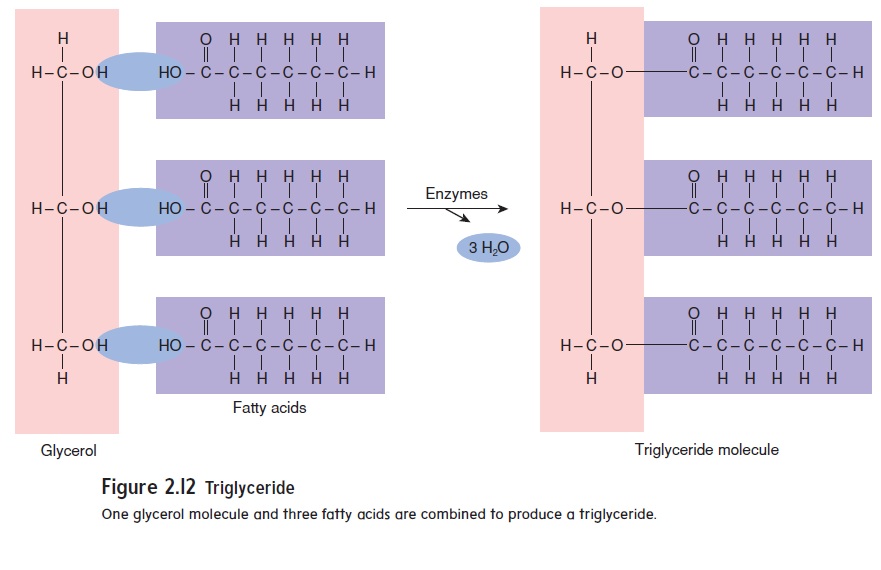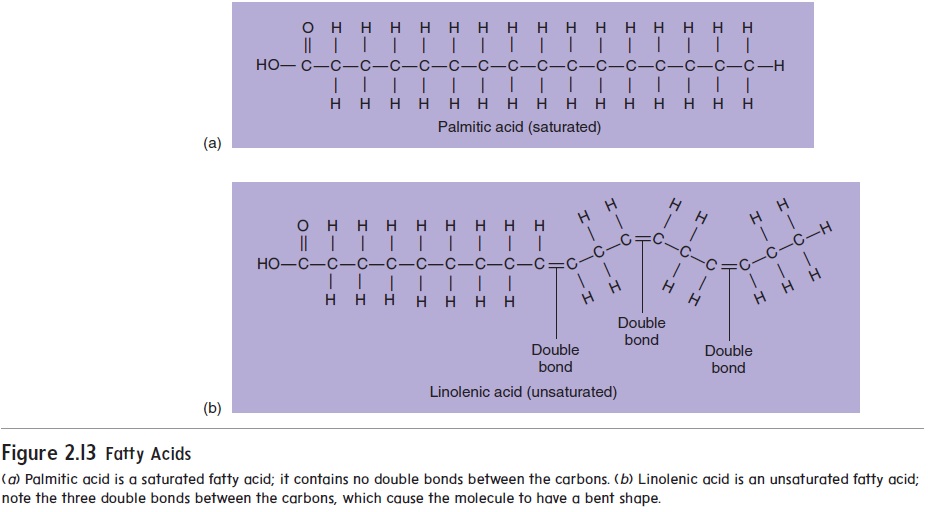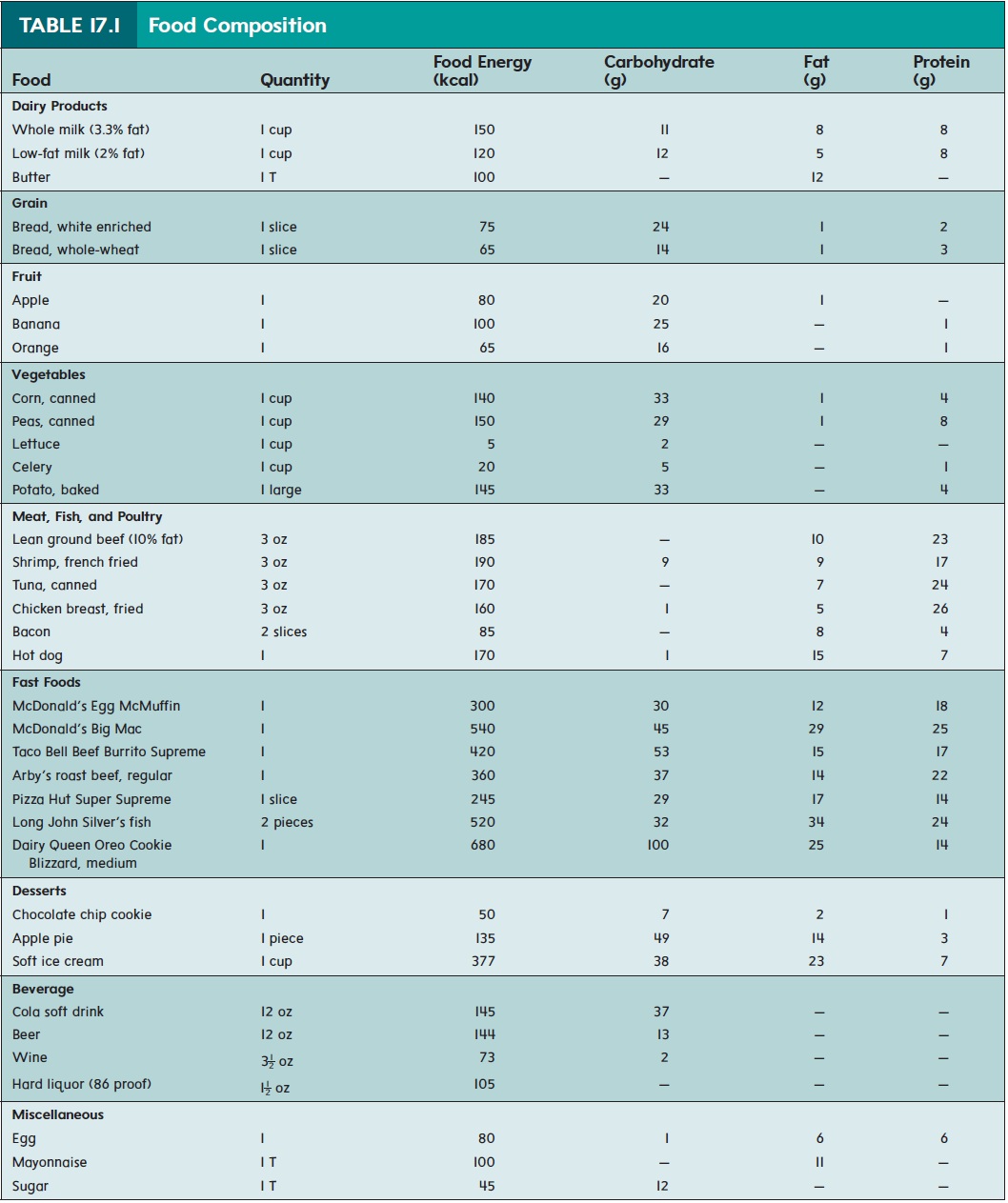Chapter: Essentials of Anatomy and Physiology: Nutrition, Metabolism, and body Temperature Regulation
Lipids - Human Nutrition
Lipids
Sources in the Diet
Lipids (lip′ idz) include triglycerides, steroids, phospho lipids, and fat-soluble vitamins. Triglycerides (trı̄-glis′ er-ı̄dz), also calledtriacylglycerols (trı̄-as′ il-glis′ er-olz), are the most common type oflipid in the diet, accounting for about 95% of the total lipid intake. Triglyceride molecules consist of three fatty acids bound to one glycerol molecule (see figure 2.12). Triglycerides are often referred to as fats. If the fat is a liquid at room temperature, it is referred to as an oil. Fats are saturated if their fatty acids have only single covalent bonds between carbon atoms and unsatu-rated if they have one or more double bonds (see figure 2.13). Monounsaturated fats have one double bond, and polyunsatu-rated fats have two or more double bonds. Saturated fats are foundin meat, dairy products, eggs, nuts, coconut oil, and palm oil (table 17.1). Monounsaturated fats include olive and peanut oils; polyun-saturated fats are found in fish, safflower, sunflower, and corn oils.


Solid fats, mainly shortening and margarine, work better than liquid oils in preparing some foods, such as pastries. Polyunsaturated vegetable oils can be changed from a liquid to a solid by making them more saturated—that is, by decreasing the number of double covalent bonds in their polyunsaturated fatty acids. To saturate an unsaturated oil, the oil can be hydrogenated, which means that hydrogen gas is bubbled through the oil, produc-ing a change in molecular shape that solidifies the oil. The more saturated the product, the harder it becomes at room temperature. These processed fats are usually referred to as transfats.

Processed foods and oils account for most of the trans fats in the American diet, although some trans fats occur naturally in food from animal sources. Trans fatty acids raise the concentration of low-density lipoproteins and lower the concentration of high-density lipoproteins in the blood . These changes are associated with a greater risk of cardiovascular disease. In 2006, the Food and Drug Administration (FDA) required that food labels include a detailed list of the amounts of saturated and trans fats, allowing the consumer to make better dietary choices.
The remaining 5% of ingested lipids include steroids and phos-pholipids. Cholesterol (kō-les′ ter-ol) is a steroid found in high concentrations in the brain, the liver, and egg yolks, but it is also present in whole milk, cheese, butter, and meats. Cholesterol is not found in plants. Phospholipids, such as lecithin (les′ i-thin; lekithos, egg yolk), are major components of cell membranes and arefound in a variety of foods. A good source of lecithin is egg yolks.
Uses of Lipids in the Body
Triglycerides are an important source of energy that can be used to produce ATP. A gram of triglyceride delivers over twice as many cal-ories as does a gram of carbohydrate or protein. Some cells, such as skeletal muscle cells, derive most of their energy from triglycerides.
Ingested triglyceride molecules not immediately used are stored in adipose tissue or in the liver. When energy is required, the stored triglycerides are broken down, and the fatty acids are released into the blood. The fatty acids can be taken up and used by various tissues. In addition to storing energy, adipose tissue surrounds, pads, and protects organs. Adipose tissue located under the skin is an insulator, which helps reduce heat loss.
Cholesterol is an important molecule with many functions in the body. It is obtained in food, or it can be manufactured by the liver and most other tissues. Cholesterol is a component of the cell mem-brane, and it can be modified to form other useful molecules, such as bile salts and steroid hormones. Bile salts emulsify fats, which is important for fat digestion and absorption . Steroid hormones include the sex hormones estrogen, progesterone, and testosterone, which regulate the reproductive system. Eicosanoids, which are derived from fatty acids, are involved in inflammation, tissue repair, smooth muscle contraction, and other functions.
Phospholipids are part of the cell membrane and are used to construct myelin sheaths around the axons of nerve cells. Lecithin is found in bile and helps emulsify fats.
Recommended Consumption of Lipids
The AMDR for fats is 20–35% for adults, 25–35% for children and adolescents 4 to 18 years of age, and 30–35% for children 2 to 3 years of age. Saturated fats should be no more than 10% of total kilocalories, or as low as possible. Most dietary fat should come from sources of polyunsaturated and monounsaturated fats. Cholesterol should be limited to 300 mg (the amount in one egg yolk) or less per day, and trans fat consumption should be as low as possible. These guidelines reflect the belief that excess amounts of fats, especially saturated fats, trans fats, and cholesterol, contribute to cardiovascular disease. The typical American diet derives 35–45% of its kilocalories from fats, indicating that most Americans need to reduce their fat consumption. See table 17.1 for a sampling of the fat composition in foods.
If a person does not consume enough fats, the body can syn-thesize fats from carbohydrates and proteins. Linoleic (lin-ō -lē ′ ik;linum, flax+ oleum, oil)acidandalpha linolenic(lin-ō-len′ik)acid are called essential fatty acids because the body cannot syn-thesize them, so they must be ingested. They are found in plant oils, such as canola or soybean oil.
Related Topics